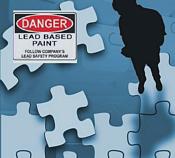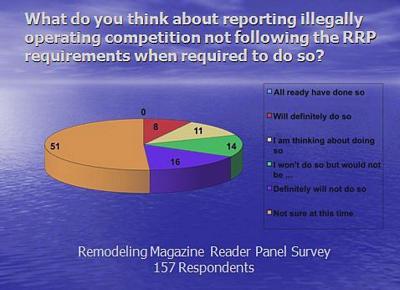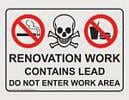OSHA Left Out Of RRP Rule Development, Just Getting Up To Speed.
 On Friday Mark Paskell and I attended a half day LEAD Hazard Awareness workshop sponsored by the MA Division of Occupational Safety and OSHA. (Download the Power Point Presentations) Mark and I agreed we learned quite a bit of new information related to OSHA requirements that apply to RRP related work at the workshop. We have been working on developing training programs and workshops to help renovators become aware of and address OSHA rules. Attending the workshop will definitely help us enhance our future offerings.
On Friday Mark Paskell and I attended a half day LEAD Hazard Awareness workshop sponsored by the MA Division of Occupational Safety and OSHA. (Download the Power Point Presentations) Mark and I agreed we learned quite a bit of new information related to OSHA requirements that apply to RRP related work at the workshop. We have been working on developing training programs and workshops to help renovators become aware of and address OSHA rules. Attending the workshop will definitely help us enhance our future offerings.
At the workshop it became obvious that OSHA and EPA didn’t collaborate on the RRP rule or the content of the required certified renovator training curriculum. It also became obvious at the workshop on Friday that the OSHA reps in attendance were only just recently getting up to speed on the new RRP rule. When answering several attendee questions about OSHA requirements related to RRP work, I could tell the OSHA employees in the room lacked a true understanding of the required RRP work practices. Although the RRP rule went into effect on April 22, 2010 these employees said they had only recently attended any training related to the rule.
 If RRP instructors follow the EPA created instructor training manual when training renovators, they will be teaching students to do things that violate OSHA rules. (Read more here) Will it be an adequate defense if fined by OSHA to defend what you did by referring to the content of the training manual? It appears that the EPA attempted to cover its lack of clarity and understanding of OSHA rules in the training manual by adding this disclaimer where the manual covers the training of non-certified workers by certified renovators; “Note: OSHA rules may require employers to take further steps to protect the health of workers on the job”
If RRP instructors follow the EPA created instructor training manual when training renovators, they will be teaching students to do things that violate OSHA rules. (Read more here) Will it be an adequate defense if fined by OSHA to defend what you did by referring to the content of the training manual? It appears that the EPA attempted to cover its lack of clarity and understanding of OSHA rules in the training manual by adding this disclaimer where the manual covers the training of non-certified workers by certified renovators; “Note: OSHA rules may require employers to take further steps to protect the health of workers on the job”
It’s always easy to find fault, but what we need is solutions. So here are only but a few of my suggestions to EPA and OSHA:
- Rather than use fines and penalties to promote awareness and compliance, use education to help employers and employees identify and understand the health and safety risks of their professions and what laws and regulations they must comply with. Knowing the why often makes the how easier to embrace.
- Rather than promote compliance with just mandatory reporting, paperwork and or fines, offer and require attendance at strategic training classes that not only explain what is required, but also why. The classes could also include training on how to fill out the required reporting forms correctly. Doing so would serve to help complying businesses who do the right things for their workers and customers, only to then get fined due to paperwork errors.
- Allow OSHA and EPA to keep the money collect in fines provided that use of this money is clearly targeted towards developing and supporting education that results in a better educated workforce, improved awareness of related health risks and reducing worker injuries and or illnesses.
- Perhaps our industry could establish standard designations for workers who satisfactorily complete a predetermined curriculum of classes relevant to specific job duties and work environments. This would increase the value employees bring to employers and give employers a simple and standard way to assess the knowledge and or experience of job candidates.
 Current OSHA and RRP related rules and training seems to concentrate on what not to do, without enough time and attention on the right way to do things. With OSHA for example, fall protection rules require a business to put fall protection equipment in place and train workers when and how to use. Great, but why not also complement it with training on methods for working safely and how to avoid putting yourself in a position to fall?
Current OSHA and RRP related rules and training seems to concentrate on what not to do, without enough time and attention on the right way to do things. With OSHA for example, fall protection rules require a business to put fall protection equipment in place and train workers when and how to use. Great, but why not also complement it with training on methods for working safely and how to avoid putting yourself in a position to fall?  For RRP, the required training teaches how to contain dust and debris so it won’t spread outside the contained work area. Might renovators who follow these instructions only be increasing the health risks to workers by containing and concentrating the dust and debris in the confined work area? Wouldn’t it make sense to also train workers on lead-safe work practices that actually limit or prevent the creation of dust to begin with?
For RRP, the required training teaches how to contain dust and debris so it won’t spread outside the contained work area. Might renovators who follow these instructions only be increasing the health risks to workers by containing and concentrating the dust and debris in the confined work area? Wouldn’t it make sense to also train workers on lead-safe work practices that actually limit or prevent the creation of dust to begin with?
If you have suggestions to add to this list please share them here. If some day we have the opportunity to revise these rules and or the strategies used by our government to administer them, we will already have a collection of solutions to consider and offer.

 Looking for accurate information about the EPA RRP rule?
Looking for accurate information about the EPA RRP rule?  Although every “legal” remodeler I have spoken to expresses concerns about illegal competition doing their work in violation of the RRP rule, these remodelers are split about whether to report their illegal completion or not. At the Opening Session I presented on Thursday morning at the Remodeling Show I offered my point of view on this. I suggested that illegal contractors and the home owners who hire them are stealing business and money away from legal remodelers and their employees. I gave the example that if you or I steal a TV from someone and get caught, we must return the TV and suffer any consequences. If an illegal contractor or home owner steals a deck job from a legal contractor little or nothing is ever done and the home owner gets to keep the deck. How long will our industry and the trade associations that represent us tolerate this? Just like with illegal immigration, because our government does not enforce existing rules and laws on a consistent basis, illegal contractors operate with little fear of being caught and even if caught, have little fear of any consequences.
Although every “legal” remodeler I have spoken to expresses concerns about illegal competition doing their work in violation of the RRP rule, these remodelers are split about whether to report their illegal completion or not. At the Opening Session I presented on Thursday morning at the Remodeling Show I offered my point of view on this. I suggested that illegal contractors and the home owners who hire them are stealing business and money away from legal remodelers and their employees. I gave the example that if you or I steal a TV from someone and get caught, we must return the TV and suffer any consequences. If an illegal contractor or home owner steals a deck job from a legal contractor little or nothing is ever done and the home owner gets to keep the deck. How long will our industry and the trade associations that represent us tolerate this? Just like with illegal immigration, because our government does not enforce existing rules and laws on a consistent basis, illegal contractors operate with little fear of being caught and even if caught, have little fear of any consequences.
 As we all wait to see what happens with the economy and how long a real recovery will take, I predict that their ability to pay their mortgage and put food on the family table will persuade many remodeling business owners to take action and defend their ability to run honest businesses.
As we all wait to see what happens with the economy and how long a real recovery will take, I predict that their ability to pay their mortgage and put food on the family table will persuade many remodeling business owners to take action and defend their ability to run honest businesses. If home buyers aren’t aware of lead paint or the implications of buying a property that has or may have lead paint, a good home inspector may likely provide such knowledge.
If home buyers aren’t aware of lead paint or the implications of buying a property that has or may have lead paint, a good home inspector may likely provide such knowledge.  Home inspectors will help cause compliance with the EPA RRP rule in a few ways. First, they will likely make home buyers aware of the fact that if built before 1978, the home may likely contain lead paint. The only way to verify if lead paint is present is to do a lead test. Inspectors can suggest their clients ask the seller if the home has been tested and if it has to obtain a copy of the required lead inspection report. Next, if the home does have lead, or it hasn’t been tested, inspectors should inform the buyers that any renovations to the home would need to be done using lead-safe work practices. This will have two effects. The first would be to let the buyer know that lead-safe work practices are required should they be planning any renovations after purchasing the home. Second, and most critical, would be to verify that any recent renovations done at the home were done using lead-safe work practices and to verify this by making sure who ever did the work did it in compliance with the EPA RRP requirements. Again, requesting a copy of the
Home inspectors will help cause compliance with the EPA RRP rule in a few ways. First, they will likely make home buyers aware of the fact that if built before 1978, the home may likely contain lead paint. The only way to verify if lead paint is present is to do a lead test. Inspectors can suggest their clients ask the seller if the home has been tested and if it has to obtain a copy of the required lead inspection report. Next, if the home does have lead, or it hasn’t been tested, inspectors should inform the buyers that any renovations to the home would need to be done using lead-safe work practices. This will have two effects. The first would be to let the buyer know that lead-safe work practices are required should they be planning any renovations after purchasing the home. Second, and most critical, would be to verify that any recent renovations done at the home were done using lead-safe work practices and to verify this by making sure who ever did the work did it in compliance with the EPA RRP requirements. Again, requesting a copy of the  Additionally, if the work was done by the home owners themselves, or perhaps was done illegally by a non-complaint contractor, the only way to find out if the work may have contaminated the home with lead would be to have the home tested by a
Additionally, if the work was done by the home owners themselves, or perhaps was done illegally by a non-complaint contractor, the only way to find out if the work may have contaminated the home with lead would be to have the home tested by a 

 Many contractors seeking to comply with the new EPA RRP rule are reporting concerns and challenges about finding trade partners who are willing to operate in compliance. Many renovators have told me that their trade partners have flat out refused to get their businesses and workers certified. Others have said their trade partners have committed to do so but have been slow to get it done due to the related costs. This has become quite an opportunity for some trade partners who have become certified and are marketing their certifications and services to general contractors. Several are actually offering to sub-contract the set-up, containment, demo, clean-up, cleaning verification and all related and required documentation for general contractors.
Many contractors seeking to comply with the new EPA RRP rule are reporting concerns and challenges about finding trade partners who are willing to operate in compliance. Many renovators have told me that their trade partners have flat out refused to get their businesses and workers certified. Others have said their trade partners have committed to do so but have been slow to get it done due to the related costs. This has become quite an opportunity for some trade partners who have become certified and are marketing their certifications and services to general contractors. Several are actually offering to sub-contract the set-up, containment, demo, clean-up, cleaning verification and all related and required documentation for general contractors. Who will take care of the notification requirements and documentation of same before the job begins? Under the rule, either can do so, but the business under contract with the property owner must maintain the required documentation.
Who will take care of the notification requirements and documentation of same before the job begins? Under the rule, either can do so, but the business under contract with the property owner must maintain the required documentation. The first time a RRP fine is accessed for a violation the finger pointing will start, causing one or both businesses to get serious about certification and compliance. The first time a renovator is sued by a client or neighbor as a result of the actions of a trade partner, the tactics used by the lawyers will cause both businesses to have a new and different outlook on RRP compliance, insurance coverage amounts and indemnification clauses.
The first time a RRP fine is accessed for a violation the finger pointing will start, causing one or both businesses to get serious about certification and compliance. The first time a renovator is sued by a client or neighbor as a result of the actions of a trade partner, the tactics used by the lawyers will cause both businesses to have a new and different outlook on RRP compliance, insurance coverage amounts and indemnification clauses.  To confuse matters even further, under their definition of the difference between an employee and an independent contractor, the IRS says that a contractor cannot supervise the work or workers of a sub contractor. Doing so might result in the IRS labeling the sub contractor as an employee. If this were to happen it could trigger addition payroll taxes and workers compensation costs for the general contractor.
To confuse matters even further, under their definition of the difference between an employee and an independent contractor, the IRS says that a contractor cannot supervise the work or workers of a sub contractor. Doing so might result in the IRS labeling the sub contractor as an employee. If this were to happen it could trigger addition payroll taxes and workers compensation costs for the general contractor.
 I suggest you check out the introduction section in the policy document. Although the policy document is intended to provide guidelines for EPA Enforcement staff, the document introduction also states:
I suggest you check out the introduction section in the policy document. Although the policy document is intended to provide guidelines for EPA Enforcement staff, the document introduction also states: 
 Second, the warning signs and barriers required to be put in place around exterior and common area containment areas will have a similar effect of raising concern. Unless properly educated about their options and about lead-safe work practices, neighbors and the parents of children attending child occupied facilities will again suffer from ignorance about lead. Many will likely react out of fear. This fear may potentially result in reporting a renovator and causing an inspection, even if the renovation work is being done within compliance.
Second, the warning signs and barriers required to be put in place around exterior and common area containment areas will have a similar effect of raising concern. Unless properly educated about their options and about lead-safe work practices, neighbors and the parents of children attending child occupied facilities will again suffer from ignorance about lead. Many will likely react out of fear. This fear may potentially result in reporting a renovator and causing an inspection, even if the renovation work is being done within compliance.  Remember, as a business you are guilty until you prove yourself innocent at your own expense. An OSHA and or RRP inspector will likely be able to find at least one violation of some rule if they show up at one of your jobsites. Some inspectors may even feel it is their obligation to find a violation. The cost to defend yourself might be as high as the cost of any fines, so even if you win you lose. In Massachusetts, the Department of Occupational Safety (DOS) is already collaborating with OSHA regarding what to do if either finds a violation that should be referred to the other. Oh, and don’t forget those neighbors who have a bone to pick with your customer, have nothing else to do all day, and or are just plain paranoid.
Remember, as a business you are guilty until you prove yourself innocent at your own expense. An OSHA and or RRP inspector will likely be able to find at least one violation of some rule if they show up at one of your jobsites. Some inspectors may even feel it is their obligation to find a violation. The cost to defend yourself might be as high as the cost of any fines, so even if you win you lose. In Massachusetts, the Department of Occupational Safety (DOS) is already collaborating with OSHA regarding what to do if either finds a violation that should be referred to the other. Oh, and don’t forget those neighbors who have a bone to pick with your customer, have nothing else to do all day, and or are just plain paranoid. In addition to the OSHA rules contractors should already have been aware of related to worker safety, the EPA RRP rule has added yet additional OSHA concerns for renovators. One for example is working on a surface covered with plastic. OSHA considerations related to working on plastic are not part of the curriculum delivered during the required EPA certified renovator training. Due to the absence of this information, the EPA is essentially leaving it up to renovators to become aware of such considerations on their own. Once aware, renovators must seek out the information they need and adjust their work practices accordingly to avoid fines from OSHA should they get randomly inspected. Or worse, have a worker accident.
In addition to the OSHA rules contractors should already have been aware of related to worker safety, the EPA RRP rule has added yet additional OSHA concerns for renovators. One for example is working on a surface covered with plastic. OSHA considerations related to working on plastic are not part of the curriculum delivered during the required EPA certified renovator training. Due to the absence of this information, the EPA is essentially leaving it up to renovators to become aware of such considerations on their own. Once aware, renovators must seek out the information they need and adjust their work practices accordingly to avoid fines from OSHA should they get randomly inspected. Or worse, have a worker accident.  This begs a few questions. First, were the authors ignorant of such considerations? Asked another way, does the left hand know what the right hand is doing? Is this another example of a breakdown in communication between very significant departments of our government charged to look out for our best interests? A second question might be; did the authors of the EPA RRP rule leave this information out of the rule for a strategic purpose? Perhaps this is just one more way to force small independent businesses out of the construction industry in favor or labor unions.
This begs a few questions. First, were the authors ignorant of such considerations? Asked another way, does the left hand know what the right hand is doing? Is this another example of a breakdown in communication between very significant departments of our government charged to look out for our best interests? A second question might be; did the authors of the EPA RRP rule leave this information out of the rule for a strategic purpose? Perhaps this is just one more way to force small independent businesses out of the construction industry in favor or labor unions.  Of bigger concern should be the distribution of misinformation at the certified renovator training. For example, using the sample signage included in the EPA approved training manual (required to be posted outside contained work areas), might just get you in trouble with OSHA. First off the RRP rule requires the use of a “warning” sign, but the sample sign is a “caution” sign. OSHA considers a warning sign to be a stronger message than a caution sign, and has rules dictating when and how to choose one versus the other.
Of bigger concern should be the distribution of misinformation at the certified renovator training. For example, using the sample signage included in the EPA approved training manual (required to be posted outside contained work areas), might just get you in trouble with OSHA. First off the RRP rule requires the use of a “warning” sign, but the sample sign is a “caution” sign. OSHA considers a warning sign to be a stronger message than a caution sign, and has rules dictating when and how to choose one versus the other.  Variances in the rule requirements, from the EPA RRP rule and also from state to state, will make it difficult for renovators to understand the differences and keep up with amendments made by each entity. Renovators working in more than one state many have to become certified firms in each state they operate in and or also with the EPA. Are renovators better off if their states write a better thought out rule? Would renovators be better served if there was just one well written rule for everyone to follow? I predict that confusion may likely contribute to violations and fines for these renovators.
Variances in the rule requirements, from the EPA RRP rule and also from state to state, will make it difficult for renovators to understand the differences and keep up with amendments made by each entity. Renovators working in more than one state many have to become certified firms in each state they operate in and or also with the EPA. Are renovators better off if their states write a better thought out rule? Would renovators be better served if there was just one well written rule for everyone to follow? I predict that confusion may likely contribute to violations and fines for these renovators.  The MA DOS has also started conducting on-site inspections. Though most inspections are triggered by citizens reporting suspected violations, the DOS is also out in the field and is stopping by renovation projects as they come across them. In one of his recent blogs, RRP certification training provider and business coach, Mark Paskell of The Contractor Coaching Partnership, shares a
The MA DOS has also started conducting on-site inspections. Though most inspections are triggered by citizens reporting suspected violations, the DOS is also out in the field and is stopping by renovation projects as they come across them. In one of his recent blogs, RRP certification training provider and business coach, Mark Paskell of The Contractor Coaching Partnership, shares a 


